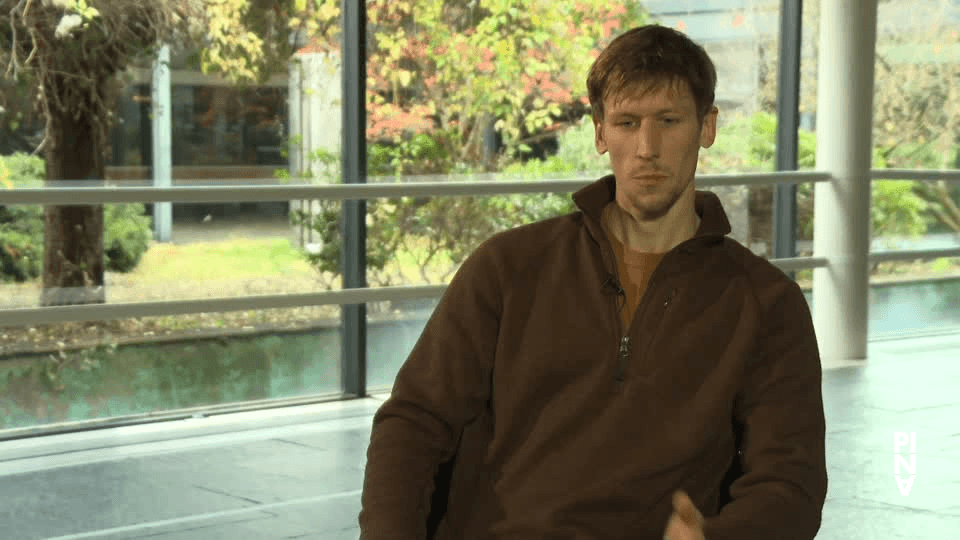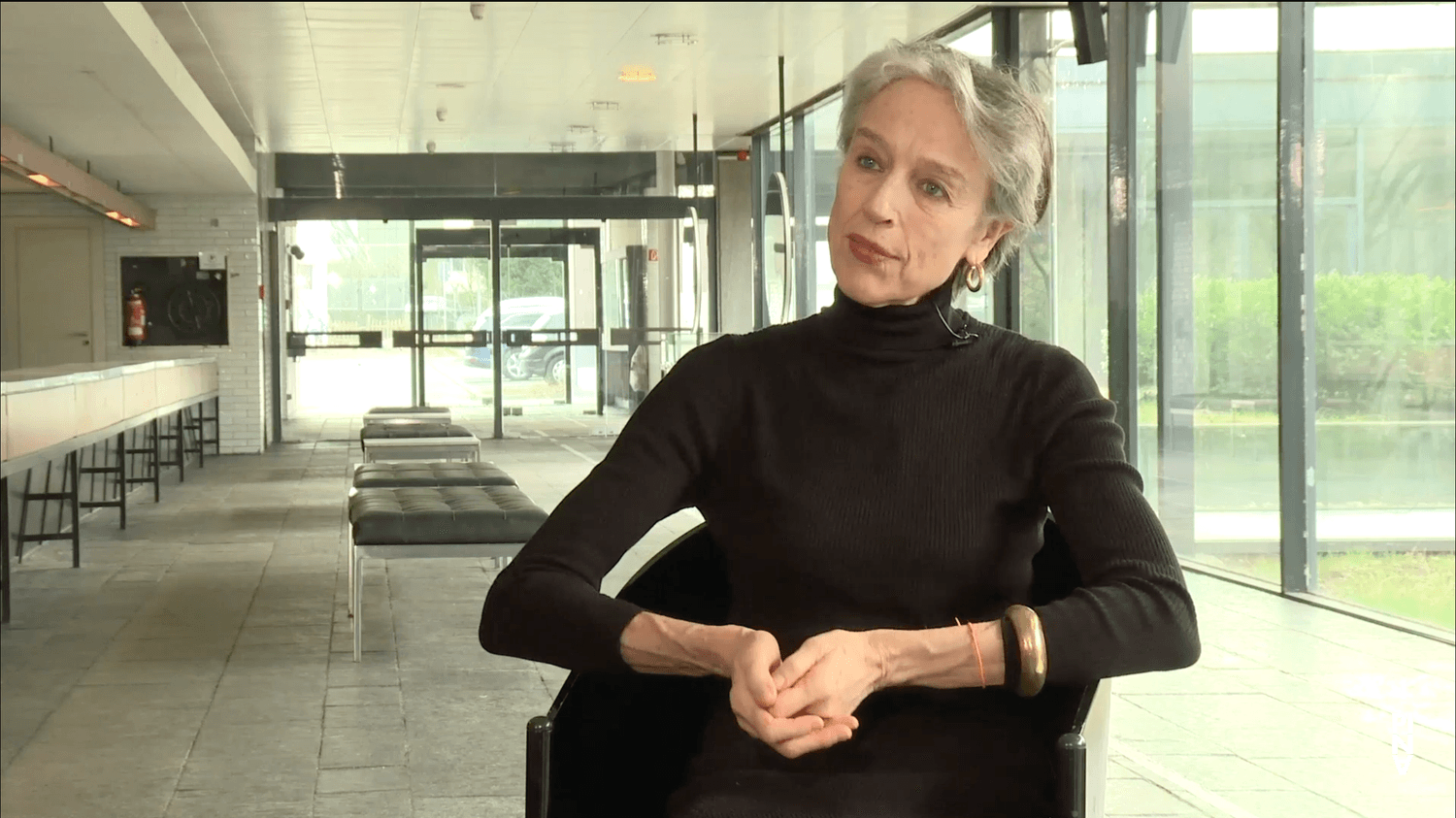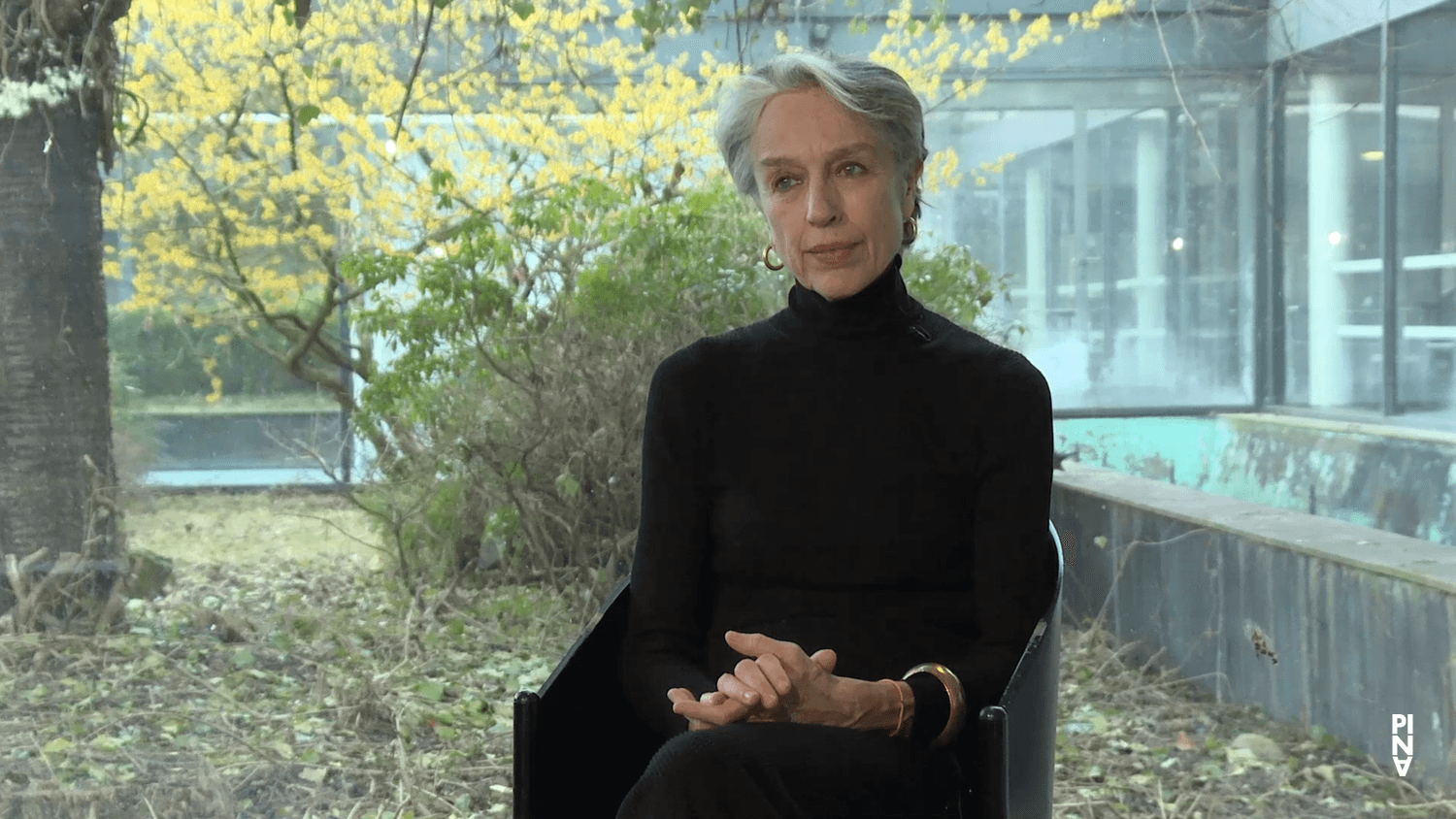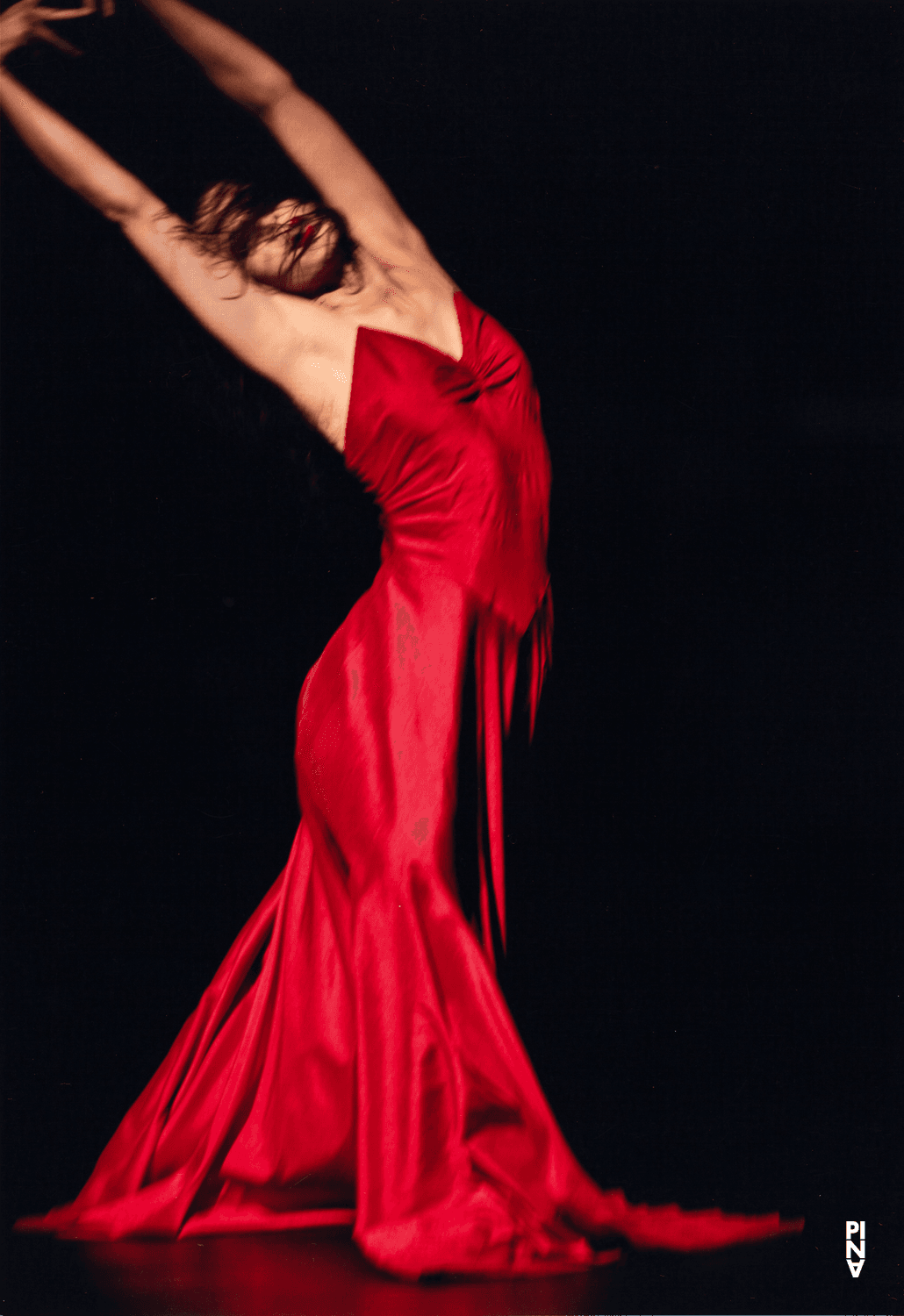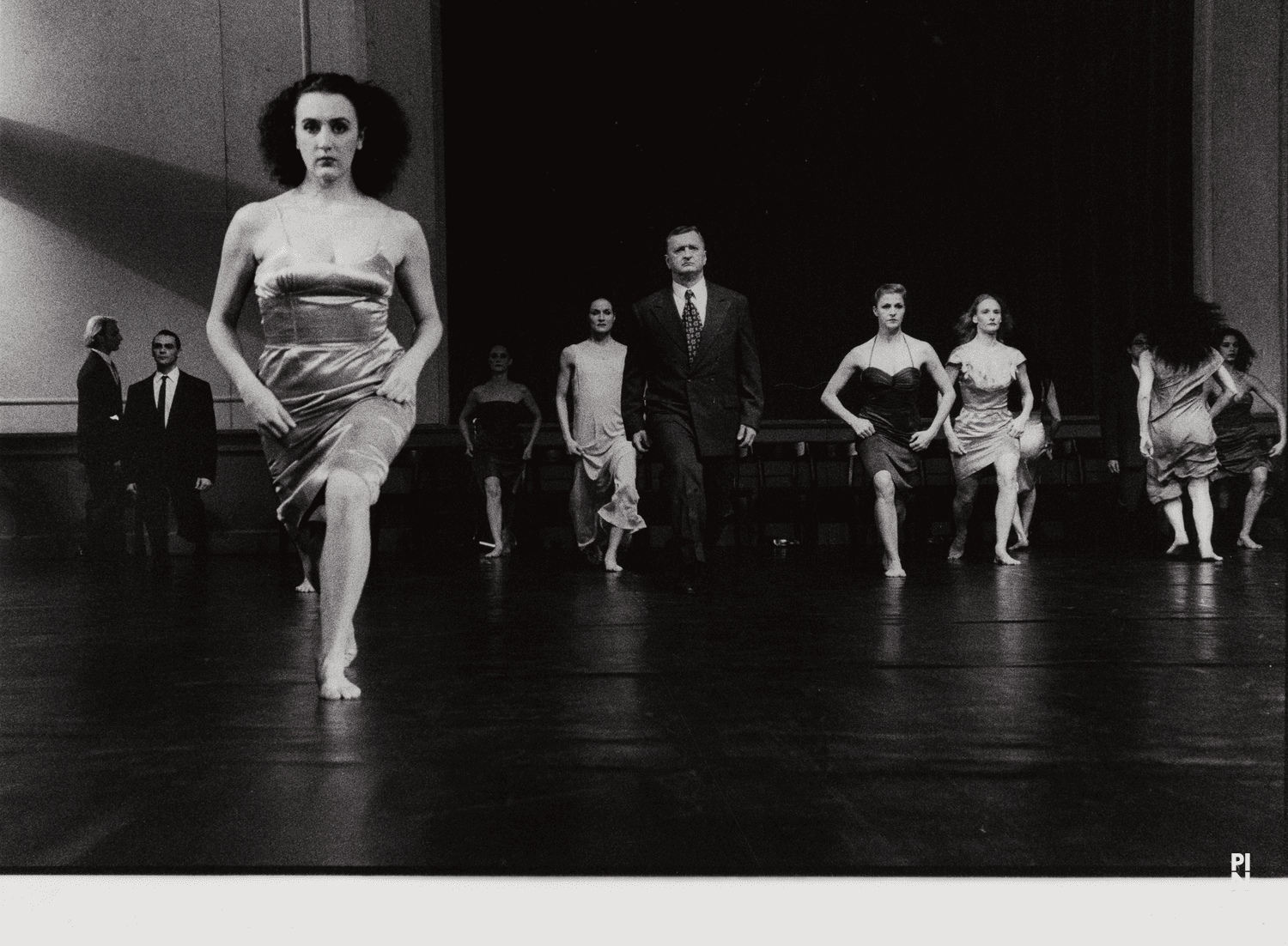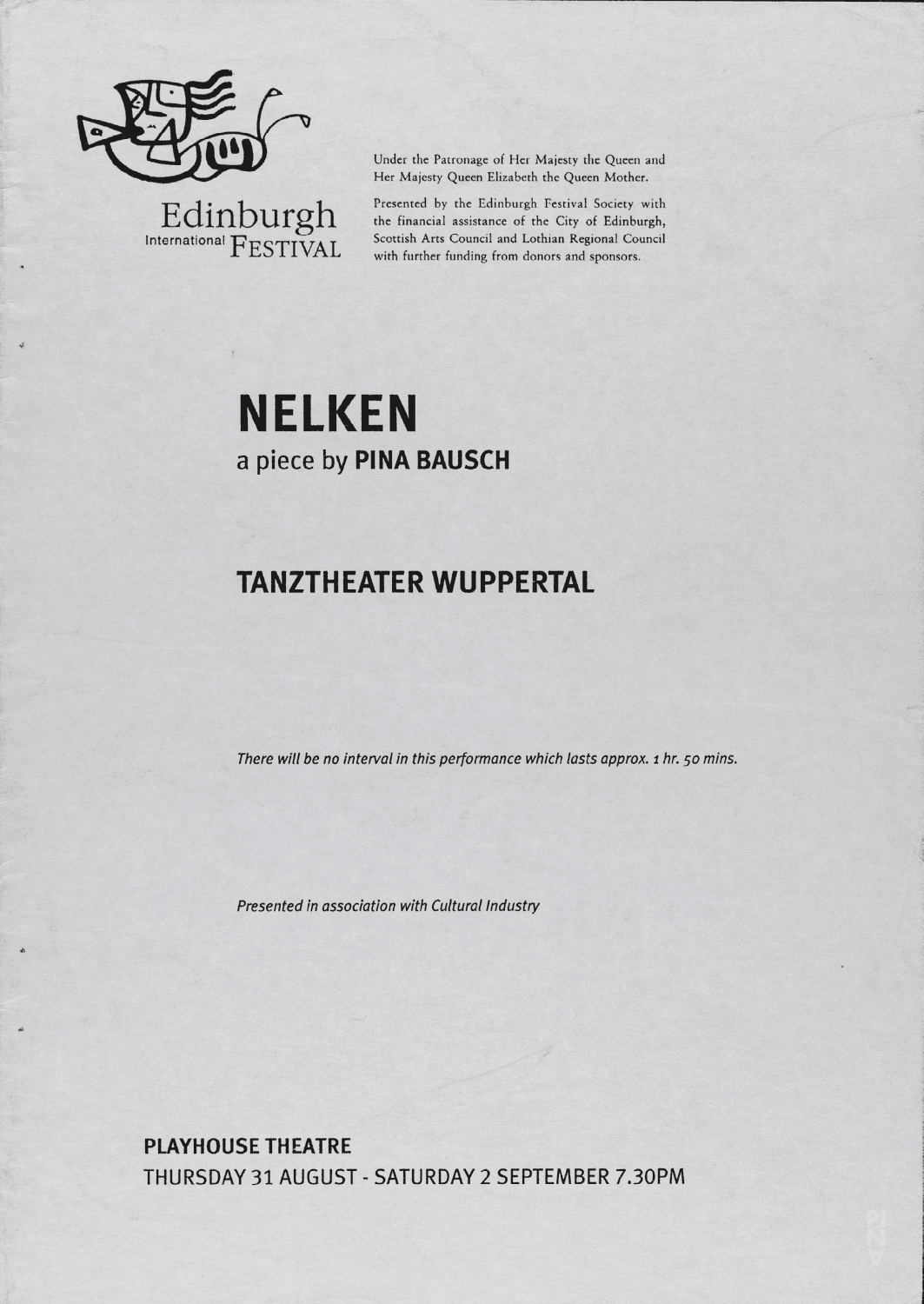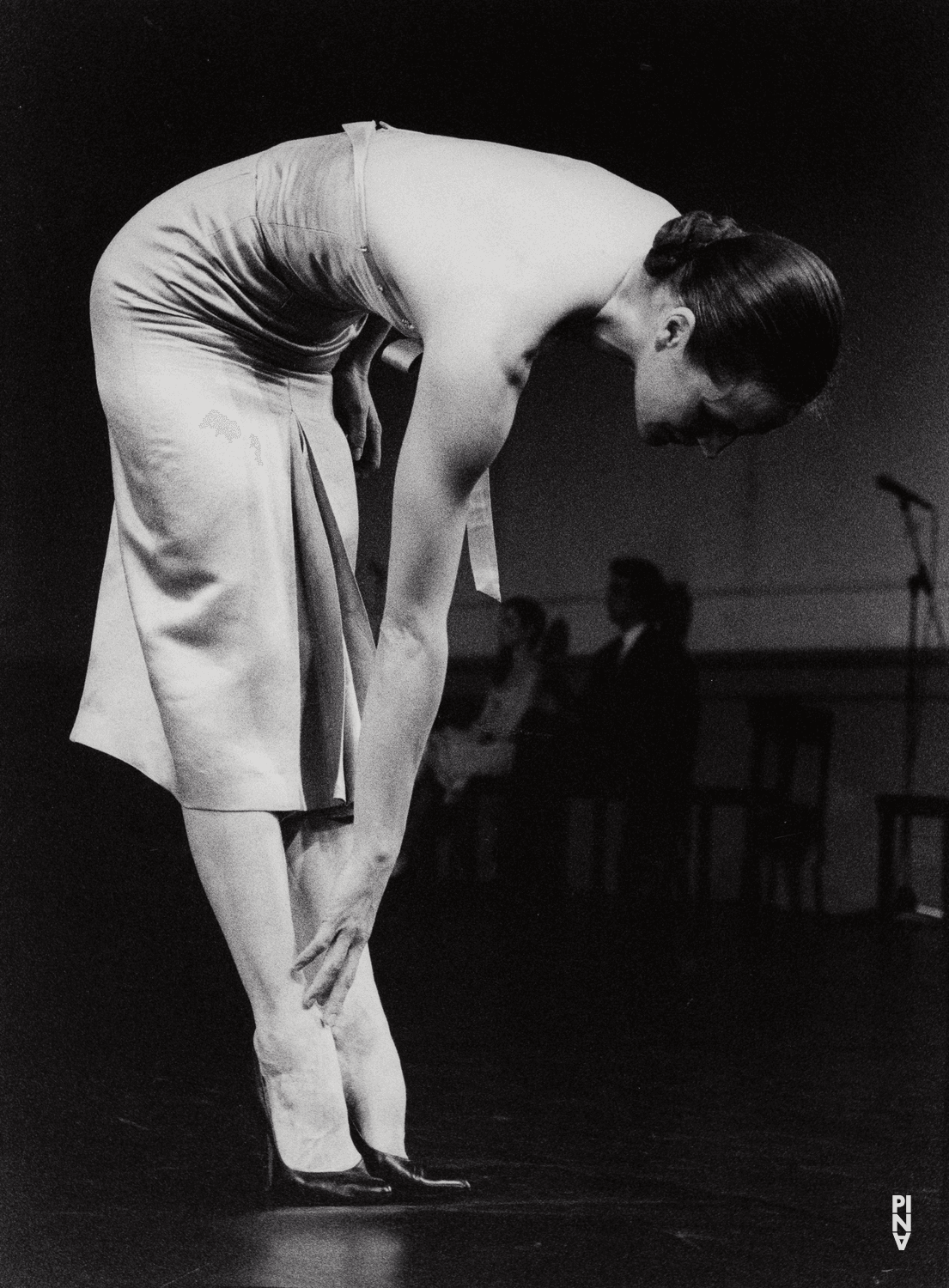Interview with Breanna O’Mara, 9/10/2018
Breanna O’Mara shares with Pina Bausch a background of studying at the Juilliard School in New York. Like the Intitute for Contemporary Dance at the Folkwang University, Juilliard is also committed to dance as an artform of the present time. The Tanztheater company is a frequent guest at BAM, so Breanna was exposed to many pieces of the repertoire live in New York. The dynamics of learning the repertoire in the later 2010s is commented in her interview. The image of the woman in the work is explored in connection with actions and the costumes. In her description of her experiences of learning Pina Bausch’s role in Café Müller she makes a fascinating argument of how the choreography is a carrier of the creator’s personality traits. The work of Pina Bausch is placed within the context of the contemporary dance world at the end of the interview.
Interview conducted in English.
| Interviewee | Breanna O'Mara |
| Interviewer | Ricardo Viviani |
| Camera operator | Sala Seddiki |
Permalink:
https://archives.pinabausch.org/id/20181009_83_0001
Table of contents
Chapter 1.1
Schauspielhaus WuppertalRicardo Viviani:
Can you tell us your memories of this place? Since you were recently here.
Breanna O'Mara:
Being a new generation member of the company, it was a nice change of energy, because it somehow felt more free. It was clean of any objects, first of all; it was just a floor and some curtains, so that we would work with lighting, but it didn't have dresses everywhere, or shoes. It was up to us to bring the things inside. Actually, I remember it first from a tour where we were checking for Underground, if it would be a good space to use and we were allowed to enter the audience and to go see. The iron curtain was down, and on it was written ‘traurig’ [sad] and there was just a broom standing next to it. This was very strong, because I’ve never actually been in the theatre to see anything. It was my first time. And then I didn’t participate in the Underground; I watched. And I was quite happy the life that could exist, and the jungles that exist. And our rehearsals? It became a home. We had our warm corners, we had the colder parts. We eventually went onto the stage where it was quite dusty, but it felt like a home for creativity, I think. It felt like you could run around and jump, and you could try things there. There was no fear to break something new, and clean. It was there for us.
Chapter 1.2
Dance and educationRicardo Viviani:
Now we can jump back to coming to dance: from hometown to Wuppertal, sort of an overview, mostly of your motivations, and where you went. Can you tell us about some of that?
Breanna O'Mara:
I grew up in a suburb of Detroit, and actually I remember dancing with my mother in the living room, her teaching me the dip – she was a disco woman –, dancing to Marvin Gaye, James Brown. I really liked Roy Orbinson. I can remember we had stairs that came down and there was a little corner, so in this triangle of the stairs I could stand. I was taller; then I could dance. Then my mother tried to put me in classes near our home, but it didn’t really last. I took a few ballet classes, then at the age of 12 I decided, ‘It’s something I really want to do.’ I was quite lucky this dance studio was two blocks away from my home so I could walk there, and I very quickly… I had a teacher, her name was Mary Lou Parker, and she created a program, where if you wanted to – we had to apply. It was called the Elite Dance Program, and we were accepted; we had to take two ballets, a jazz, and a modern class a week, and everything else we could take for free. It was the first time she tried to do it, and I took 13 classes per week. So I went to school until 3:30 and starting at 4 I was in the dance studio. Also sometimes taking the barre of the babies, and then going to my ballet class. I can’t say exactly why I wanted to…
I think I started dancing already and my aunt passed away, and then I remember one night – because I didn’t know what to do; I was 13 – and I put on music and I just danced in the dark. This is a memory I have quite strong, just the movement getting out emotions.
Not really thinking, but dancing. So I knew there was something that I liked very much about dance. I think it was the physical work, but I was not so immediately talented, physically, so I had to work and my teacher kind of let me know as well. It was not just an easy school where everybody could just dance. She wanted us to have technique, so I was trying to get all of the information.
Breanna O'Mara:
Every two years we had a recital, so that we could also focus on technique. In Michigan there were not so many performance opportunities. Sometimes we did small performances in the street at a festival, or we would go to competitions — it’s a typical American thing (laughs) —, not with the idea to compete, but to have a chance to perform. And then I was able to do my first solo, and since the age of 14 or 15 I had a solo every year. I started to do summer programs. The American Ballet Theatre had a program in Detroit; I don’t think they do anymore. So that was the first time I went intensively all-day dancing with young people from around the country. And I also saw the quality that existed, at a young age, which motivated me even more.
And I had a chance to go to New York to do the Alvin Ailey program, which was a dream! I spent six weeks in New York dancing with another friend of mine. Then we would go alone once a year, just for a weekend to take classes. When I was 16 or 17, I auditioned by VHS tape (laughs) with a ballet barre, and a solo for the Juilliard Summer Program. I was accepted. I actually didn’t know what it was, but a teacher of mine suggested: ‘You’ve done American Ballet Theatre twice. Why don’t you try?’ I went there for three or four weeks. At the time I was searching for a university. It felt really like where I wanted to be, like home. And the teachers – it had an energy; I just felt I wanted to go there. I was very focused the whole next two years, remembering the corrections those teachers had given me, trying to get ready for the audition. Actually at the time I was not sure if I would also study medicine; I was quite into science. But I auditioned for Juilliard in Chicago, and made it to the end. And I had a phone call some months later that I was accepted, so it was clear: I go.
Chapter 2.1
Tanztheater Wuppertal at BAMBreanna O'Mara:
I started at Juilliard in 2007. I graduated in 2011. And it was there where I first saw Tanztheater Wuppertal Pina Bausch. Bamboo Blues was the first piece I saw at BAM. Growing up in Detroit – I am sure YouTube had just started, but I didn’t use it. When I got to university is when I started to see much more dance. There were not so many companies coming to Detroit. The old videos that I could see were VHS; I found Fosse or ballet. So in BAM I saw the company. I was amazed. I didn’t know you could do that with theatre or with dance. It was a dance performance at BAM. And I felt I understood it. I understood the emotions. I felt something. I was amazed by the variety of people onstage. I understood that as a type of theatre that spoke to me, something I’d want to do. And in school I was quite a good student. I did all of my classes, I listened. But I always felt a bit less knowledgeable, technically. In Juilliard you are surrounded by some of the most virtuosic dancers in the country, also internationally. You quickly forget your own level. I felt I wasn’t going to fit into this more neo-classical ballet, or something based on the virtuosic body. I also entered dance more from an emotional place. So when I saw this work it touched me very much. Then Pina passed away in 2009. I was still in school. I remember reading the New York Times article; I was at home in Detroit for the summer. And somehow I think the dream still existed, but I didn’t know at the time; I had two years until I graduated, and I felt, ‘maybe this is no longer a possibility.’ And in my senior year the director of the school, Lawrence Rhodes, told me it would be a good idea in few years; maybe I should visit. Maybe it’s something to look into. So he gave me Sabine’s email. I emailed, but the company was on holidays when I was visiting, in the winter. It stayed there as a little seed perhaps, but it was clearly not the time.
Chapter 2.2
Exposure to Pina Bausch’s workBreanna O'Mara:
After I graduated, I stayed in New York. I didn’t know what I was going to do. I took a workshop with Johannes Wieland. He is the director in Staatstheater Kassel. He asked me to come for a project. So I started in Kassel. I just went to work for one month and I thought, ‘If I am here, I am going to stay and see some things.’ So I came to take training with the company, finally. I stayed with Julian, a colleague, in Essen-Werden. We took class with the company, we took ballet. At the time I was not allowed to watch rehearsals, so I watched videos. I watched Orpheus and 1980. I took class at Folkwang as well.
Chapter 2.3
AuditionBreanna O'Mara:
And then I was in Kassel until I auditioned here in 2013, I suppose. At the time we had to mail in our résumé, our CV, with a photo. I remember being very nervous in case they didn’t receive it by post. I didn’t know how I could check. And then I was invited to the audition.
The first day we all had to meet at the opera house and they walked us to Gemarker Ufer, near the Alter Markt, near the Lichtburg. There was an empty storefront. And I remember Lutz was there at the door. He greeted everyone. And we just had to wait, 300 women in an empty storefront. (laughs) We did four or five ballet classes, ordered by name. Then they said, ‘You have some time until your class.’ And we just did a ballet class, then running in a circle and down the diagonal the first days, and perhaps Two Cigarettes in the Dark, something charming.
The next day, ten in the morning Rite of Spring. I remember the Viktor ‘Frauen’ movements. I remember Helena very strongly, with movements from Viktor, doing this (gestures), giving corrections. It was a very long day. I think we went on until nine at night. And just always the group getting smaller; already after the ballet class they cut half. So the next day we were 150; after The Rite of Spring they cut another half. And I was just trying to be present. (laughs) I didn’t want to put too much stress [on myself]. I just wanted to be there, to listen to what was being said. I actually couldn’t believe I was in this room with the people I had seen on the stage.
Chapter 2.4
Second day of auditionBreanna O'Mara:
By the end I think we were about 20. And then Lutz called seven names that they would want to see again for a callback. I remember thinking after The Rite of Spring, ‘I can’t move anymore.’ (laughs) We did it for one hour, just this Große Stelle [major passage]. I was quite exhausted but really amazed, almost like at the end of the Juilliard audition, where you’ve made it to the end, and can’t believe it. You still have another step, but.... And actually I was quite nervous because since my Juilliard audition I had never made it past the ballet class in an audition. I did many of them, after graduation, or in my last year, and I was always cut with ballet. So I was nervous this would be the same situation. I tried to remember my [Corvino training] – I have Corvino training as well. Andra Corvino was my teacher in Juilliard. She is the daughter of Alfredo. (laughs) Then we did a callback a month later, just seven of us. We had to bring a dress and heels. It was another full day of nine hours or so. It ended with the solo from Helena in Two Cigarettes in the Dark, Julie’s solo from Agua, some improvisations with text. Oh and Nelken, Dominique: ‘What do you want from me?’ (laughs) I remember doing battements, pirouettes, and voguing eventually.
And it ended with speaking. One by one we had to speak to the whole table. It was quite a jury: Lutz, Dominique, Helena, Julie Stanzak, Julie Shanahan, Nazareth, Rainer, Fernando, perhaps more rows; Barbara was sitting there. We left, and I got a phone call a few days later from Lutz, that they would like to try, then I came here. (laughs) A bit of a story.
Chapter 2.5
Pina & JuilliardRicardo Viviani:
It’s a big stretch, but I’ll go just a little back to Juilliard. Were you aware of some connection of Pina Bausch with Juilliard?
Breanna O'Mara:
Yes, I knew that she had gone for a year to the school. But I learned much more about it once I came here.
Chapter 2.6
Media exposureRicardo Viviani:
Did you look at the videos that were out there at that time?
Breanna O'Mara:
We only watched The Rite of Spring, in our Dance History class. No, I was a bit too busy in my studies somehow. (laughs)
Chapter 2.7
Prepared for what was to comeRicardo Viviani:
Did you come prepared with your point shoes for the audition?
Breanna O'Mara:
(laughs) I think I maybe did bring them, in case. I mean, I knew the work of the company. Every time they came to New York I watched. And by that time everything you could find on YouTube you watched.
Chapter 3.1
First impressionsRicardo Viviani:
So you landed this job. That’s the season of 2014/15. Which piece did you learn first?
Breanna O'Mara:
Sweet Mambo. I entered the company and there was a tour right away to Edinburgh to the International Festival. I came as extra, as Erzatz, so I could watch Clémentine still doing it. It’s an extra place; now I know that it originally didn’t exist, but somebody could not do group parts so Pina put Clémentine in it, then liked to have this person in there, and kept it. So I watched. I don’t know if it was one week or two weeks after the start of the season. It was very fast that we went to Edinburgh. It was quite nice, because I was able to watch the performance every night, a nice chance to slowly enter it. But afterwards we performed in Wuppertal, and I was in the piece.
Breanna O'Mara:
Right after that was Kontakthof. That was a big one. We took it to BAM, to New York. It was October, so I’d been here for a month and a half maybe – suddenly onstage in my home country. Also, on a stage that I never really thought I would be on. It’s one thing to watch the performances; it’s another thing to really imagine you’re inside of it. (laughs) At the time, Ophelia and I were the first new women, so we had a lot of people to help to carry you through, to feel the energy as well. But I loved it to do it there. It was really great. After Kontakthof we did Gebirge, but I was doing part of Anne Martin’s part, with the slapping of the face, with the old men’s orchestra. I did Kinder, the group parts for Helena. Nelken I think we also did. It is hard to remember which years I learned which pieces. Ah, Palermo, I learned Palermo.
Breanna O'Mara:
No. Do you want to hear all of the pieces that I learned? The interesting thing is that in Gebirge now I’ve learned Helena’s role, so I’ve had a change there.
Chapter 3.4
Gowns and beautyRicardo Viviani:
It’s a very unique way of being onstage. The gowns, which are a very unique thing, these are gowns that you would not see [everywhere], especially in America; the gowns became way fluffier. (laughs) How does that feel to you?
Breanna O'Mara:
The first dress that I got to put on for Sweet Mambo I couldn’t believe. I felt so beautiful. I thought, ‘I’ve never been this beautiful. I’ve never worn something so beautiful.’ (laughs) But I was very nervous to dance in it. I just had a small part to dance towards the end. Everybody does a phrase from Michael, and I was practicing, practicing – because we don’t get the dresses before, so backstage I was just trying to practice knowing how to stand up from the floor with all of this fabric around your feet. It is very nice. It’s a simple silky material, pink and purple, and browns. I still think it’s so special to put on this dress. It definitely changes immediately your inner feeling as well. It’s this elegance that I know more from my grandmother, or from the movies that I would watch with my mother. It is not something that in my generation we necessarily wear – daily.
Chapter 4.1
Different womenRicardo Viviani:
Gender today is a big theme. Is there a different image of the woman contained in this universe? How does that relate to your experience?
Breanna O'Mara:
For me it’s changing often depending on the piece. We just did Masurca Fogo and my role there is from Anne Rebeschini originally. I don’t know if it’s necessarily the woman that I am, or that I feel I am. It’s a bit more, maybe, shy/coy. It’s showing the legs; it’s playing with these things that are of course beautiful, but…I think the thing is that I often feel still in power as a woman in the work. I don’t feel that I am playing a stereotype from the 1950s. There’s a reality to the fact that there is violence against women, and there are different standards. But I definitely still feel the power there. The difference is that when I look around today, the actual image or style has changed a lot. But I actually feel that the pieces were already playing 1940s even in the 80s. But it’s just an aesthetic, it’s a style more, but the substance is still very relevant as a woman. If I think of Gebirge for example, it’s very strong, and I think it applies completely today, with ‘Gewalt küssen’ or ‘Say ‘Uncle’’.
Chapter 4.2
Relating to the original personRicardo Viviani:
Did you learn a specific person’s role throughout the repertory?
Breanna O'Mara:
Oh, no. I mean I’ve definitely worked a lot with Helena, but I’ve also done other people’s parts. So yes, I’ve done her parts. (laughs) I’ve also done parts that she’d also done, but for example in Palermo I do Finola, or Anne Martin was first my Gebirge; I do 1980. Anne Rebeschini, Helena: no, it’s not just one. But definitely it’s more in the tall person spectrum, tall woman spectrum. (laughs)
Chapter 4.3
One favouriteRicardo Viviani:
Is there one specific piece in the repertoire, that you’d say, ’That’s the one piece that I am really looking forward to,’ or is a special challenge? These are two questions in one, I know. (laughs) Is there one that you’d pick, for one reason or another?
Breanna O'Mara:
I think that’s also changing based on my feelings or emotions. I have performed Viktor quite often. It’s a very challenging piece. It’s a very touching role. It’s a very strong piece, anyways. I enjoy it very much. It also brings a certain amount of, maybe not fear, but a pit in my stomach. I would say Auf dem Gebirge is another one; that is a big challenge. I haven’t performed it so often, but it also leaves a pit. Actually, it is very hard for me to say which. I know that I am quite lucky with the roles I’ve been able to play, in many ways. And Café Müller is one that I almost couldn’t believe I was going to do, and now we’re doing it. Now it feels like it was a dream. Going into it again is quite a wall to face, to climb over.
Chapter 5.1
Casting in the role of Pina BauschRicardo Viviani:
Wonderful now we have a hook into Café Müller. How did that come to be? What was the commission to go look into this? How did that happen?
Breanna O'Mara:
There was this idea to start with second casts, or at least to have understudies for parts. Lutz was the director still. I learned Nazareth, which is Meryl Tankard. Actually a few of us, myself, Tsai-Chin, Emma and Blanca, we learned it, and then they decided I would be the understudy, so I was first the understudy for this role. Actually, in Nîmes Nazareth had an award – she went to have brunch with the King of Spain – and I did the run-through for her. I was very nervous; [there was] live music. I think already Ophelia had learned, and was performing it, sharing the role of Malou with Azusa. I think Jonathan had not learned it yet. I am not sure. Then it was a bit strange. I was told by Robert that on behalf of Adolphe Dominique needed to speak to me, and he did not. I thought it was actually about Nelken, because the last time we performed Nelken there were last-minute cast changes. I thought, ‘Oh no, maybe I have to take [another part].’ We were getting ready for a tour of Nelken. But nothing was said until quite some months later, actually, after we had performed it already. We performed Café Müller and Sacre in Hong Kong, and I was the understudy for Nazareth. And actually right after that, when we went to Korea (laughs), at breakfast one morning Helena told me that I would learn the part of Pina, and she gave me a DVD. I was a bit shocked. I found a bit of a pity that I could have been watching it already with the idea. We didn’t start rehearsals. I just was watching the DVD to try [to learn]. She told me the first thing would be to remember the order of the movements. (laughs) So I was doing that, and I was in my break watching it. And then because I don’t have so much to do – we were doing Sweet Mambo in Korea – I was sometimes backstage trying to remember the order of movements. But we did not rehearse until the next season had started.
I had asked for rehearsals but there was no time. We just started in August. I think we had two weeks to rehearse it before we went to New York.
Chapter 5.2
PerformancesRicardo Viviani:
So, you eventually performed it how many times and where?
Breanna O'Mara:
Actually I’ve performed it three times: twice in New York and once in Ottawa.
Breanna O'Mara:
But without the turning door. And in Ottawa was the Plexiglas set.
Chapter 5.5
Beautiful movementsBreanna O'Mara:
I have to say it was quite good – I don’t think it was planned – that I was already an understudy for the piece. So I had already been around when we performed, watching it. And of course, you watch the whole thing. You always know the part and you keep an eye on your role, but you also get a chance to see it more often. I think this is good. It was always in my heart that I would love to learn these movements, when I saw them. I had already watched the film version of the piece. This I had watched before I entered the company – actually, right before I entered the company was the Pina 40 Festival. I came to watch many performances.
Chapter 5.6
Honoured to learn Pina’s partBreanna O'Mara:
I just always saw these movements and thought, ‘They’re so beautiful. I wanted really to experience that.’ So, it’s quite an honour to have this part given to you. I was also terrified. (laughs)
Chapter 5.7
Closed eyesRicardo Viviani:
With the role of Nazareth you’re around, and you are looking. You’re really present in that sense. But in the role of Pina, you come into another world. You have your eyes closed. How did that feel? Did that put yourself more in connection with yourself or with the movement? How did that work for you?
Breanna O'Mara:
It’s kind of an amazing thing that happens with your – because it’s the one character who stays the entire time on stage, and with their eyes closed. It’s not that you lose the sense of your body, but a bit the containment. There’s a sense after a while – I had small moments; I would love it if there were more – where you almost know the whole space, although you are in your one spot there; you’re against the wall or you’re sitting. It’s like another sense; you know the whole thing. I think your eyes are open you would not have this. I mean you would see it, but this idea that you know that there’s a person there and that they’re coming – I think I’m much more connected into the whole piece in this one part.
You’re connected to the whole space, but I lost a lot the sense that there’s an audience. That’s very nice as a performer, I have to say. (laughs)
Chapter 5.8
Reacting to the soundRicardo Viviani:
What about the acoustic world with the noise of the chairs being thrown? Is that a scary thing?
Breanna O'Mara:
Sometimes yes. I mean you really do feel this... Because of course, you don’t know where… You hear the sound, and I think it makes it more real also then. Of course, you also have the moments to walk through and when this starts she – Pina’s role – often breaks the movement and continues walking or searching back for the wall. So it can be very real. (laughs) I was hit once.
Chapter 5.9
Performance ritualsRicardo Viviani:
Do you have a special preparation ritual for the role?
Breanna O'Mara:
I try to watch DVDs of Pina as often as possible. Now when we revisit it, I think I will watch more generations of it. I [already] did, but we focused on a close-up video from 2000. The whole video is just close up on Pina and it’s a much gentler version. She’s already older, and also because I was nervous and young, and sometimes I have fast muscles, it was a good version for me to watch. I felt I could almost see her doing the whole piece like a film in my own brain. I was watching that also the night before I head to premiere it. Then I just tried to calm down. I did a short barre before. I made myself warm and tried to stretch and have weight. Then with the actual performance there’s always a setting of certain chairs: the chair when you enter, that then you can back up; there’s two chairs along the wall that you pass by; chairs at the table, which I learned from Helena – that there’s a table that you dance in front of. You place three chairs there, sit in each one. Helena thought it was also inviting three people from Pina’s life to sit, to be there with her: her parents and Rolf. Also, there’s a chair behind, in front of the plexiglass, towards the back. We do usually the first aria together, the two women. Then I would continue and do the second aria, and the third aria, where I have dances, just to check the space, to check the movement. Also usually, often, the second time you have a bit more weight.
Breanna O'Mara:
There’s a moment, in the times that I performed it, where I definitely – I remember specially the second performance in New York – that I have tears: towards the end of the second aria. It’s this, ‘Remember me’. The words, it’s one thing, but this aria also has quite a lot of commotion in it towards the end. There’s one final [moment], she goes to the floor and then you go towards the wall again and you hit it. This really is strong. It brought tears to me from then on. Then you go backwards…
Chapter 5.11
The Rite of Spring and Café MüllerRicardo Viviani:
And after you perform Café Müller, you do Sacre. How is that?
Breanna O'Mara:
I didn’t know how that would be. Actually, it’s quite nice, it helps. I mean I have to wear a little bit of body make up in Café Müller. It’s this F1 you put on; it makes you matt, so you’re not shiny. Also pale, but I am quite pale anyways. So, I need to go shower. I try to take it really warm, to make sure I am warm. While Café Müller is happening the Rite of Spring people start their warmup. We do a barre and then I would get my dress, go back to the studio and do every section of the piece. That was what I was used to. I don’t have the time anymore, so I would do few movements backstage before, then it was often time to start Sacre.
But there is something nice to have already danced, already been onstage. Maybe you are a bit tired, and it also gives another weight to Sacre, to not be so high and nervous. I also found that by learning the movements of Pina, I felt I also understood movements from The Rite of Spring better, the reaching, because in Café Müller she always is reaching, but there’s such a groundedness at the bottom. And it’s the same in Sacre, also; you have this yearning, this pulling in the movements, and this softness also that helps a lot. The softness that I learned in Café Müller I think exists also in Sacre. You have different dynamics, but if you can learn to keep this, and perhaps move a bit more quickly it can help to make the movements bigger or fuller.
Chapter 5.12
Creation of the pieceRicardo Viviani:
Do you know the background of the piece? Do you know the story about the premiere of the piece? What do you know about it?
Breanna O'Mara:
I mean what I understand is that it was four choreographers, four pieces, and that they had to have a red wig, table and chairs, and they were all to make a piece. And that actually they made the piece in two weeks. And then it was not enough, there was something missing and Rolf said, ‘Let’s fill it up with tables and chairs, and don’t worry I’ll take care of it.’ I don’t know if it is true. (laughs) That’s what I understood about it.
Chapter 6.1
Many sourcesRicardo Viviani:
Learning the pieces in general, there is feedback from many different sources, the many years of videos, but also from all the people around in the rehearsals. When does it start for you the moment that you say, ‘I must make decisions’?
Breanna O'Mara:
I think I am working on that more and more. It also depends on the role. If the person who created the role is there, there’s lots of information. You can ask a question directly. So with Café Müller that was quite interesting because the person is not there to ask. And even the people who are there to ask don’t necessarily know. So sometimes it’s more of a discussion. In the end I guess we’re always trying. (laughs)
Chapter 6.2
Movement as a source of personal informationRicardo Viviani:
Doing those movements, learning those movements, do you recognise that person: is doing these movements putting you in connection with that one person? The question at that point was: do you recognise Pina when you do that?
Breanna O'Mara:
I think in learning this part it was quite nice because it was a chance to try to get to know this woman, who in a way I came here for. The first time I performed it, it was… very big. It was a very big thing around, and I went, and I fully wanted to. And I also enjoyed it and felt, but afterwards, you think, ‘What – how did that happen? What did I just do?’ You can always see more. This time I was revisiting it just some weeks ago, also a bit in the summer. I felt I also saw some parts, some shades of it, that I had not seen before, which are also perhaps from her: a melancholy – well this is hard to explain; I can be completely wrong – but also a sense of one’s own, not just mortality, but death. Which is also maybe something I project, but it’s something I also feel sometimes, when you can sense it, even if it’s far away. I don’t know if it’s something she – but this I learned from watching it now, watching her. And then doing it as well, even while I was doing it I had this realisation, ’Sometimes you are the ghost in the room. You are not the…’ But this is all of my own speculation.
We were just rehearsing it with Helena in the Lichtburg, and we were watching the video. Because it was the one piece she could dance throughout the time and Helena told me that it was like a medicine for her [Pina Bausch] that she had this to do, and that originally, she was not going to be in the piece, but she was so beautiful doing the movements that Dominique and Malou said, ‘You have to be in it.’ I just heard this.
Chapter 6.3
The role of Pina BauschRicardo Viviani:
The role of Pina Bausch and also the role of Rolf don’t relate to other people directly. Does that make sense to you? Maybe being in another level [of existence].
Breanna O'Mara:
The role of Pina I see most like this. Because at least the role of Rolf is concerned with Malou and Dominique: to remove the chairs. I mean relationship-wise, yes they don’t have more of an intimate relationship like the other characters. I read so many times that the role of Pina is this ghost-like figure. At first I didn’t like to hear that. Now I also understand it. Of course, it is this solitary figure, whatever you project that happened to her: she is alone, dancing.
Chapter 6.4
Changes with the decadesBreanna O'Mara:
It’s funny, if I watch the videos from the 80s for example, it has less of this… I don’t know how to say it: she feels more present in what’s happening. A bit later, still, but more with this whole… I can’t say it. Maybe like I explained before this idea that you are also perhaps a spirit-like person, or a remembrance of… This is very hard to say! There are moments when I watch the video and see, ‘Ah, but actually it’s a representation of almost a spirit trapped in this room.’ This thing that Malou is experiencing is the same thing. And there are other times when I don’t sense that, and I don’t know if it has to do with just the performance that you happen to watch or what I am projecting at that time.
Chapter 7.1
Relevance todayRicardo Viviani:
Going through decades to this piece becoming a classic or a ‘reference piece’, and being a dancer that came into professional life in the 2010s, in your view, as a dancer coming in this generation, what is the relevance of this work at this point?
Breanna O'Mara:
Café Müller? Actually, it is quite hard to answer. In a way the dance world is not just one. There are many ways. If I think about what I see when I go to Impulstanz in the summer in Vienna, I think it doesn’t fit in the contemporary context. If I think of what I see in larger established companies, maybe in that way more classical or something, it’s showing something human, it’s showing human emotions, instead of just virtuosic bodies. (laughs) I think sometimes we are getting into a way of spectacle or show, and it’s a piece that still shows pain and longing and also simplicity: to have quiet and beauty as well.
I mean it is definitely a piece that’s inspired many more things since. Sometimes it is quite amazing to watch pieces now from other choreographers and to see references or the influence – for sure the influence Pina’s work has had – but sometimes specifically you see elements from this piece.
Chapter 7.2
De Warme WinkelRicardo Viviani:
How does it hold up? Did you see De Warme Winkel? What elements were there, and what was also lost?
Breanna O'Mara:
I was quite impressed by the opening half of their performance, with the three younger performers having a direct link and then realising what they’re saying [is the] the discussion of the three older performers in the back: the idea of passing something on. There was a point when they all stand and they were following the older performers, and they are all in the space, two by two. This was amazing to me because at the time I was still understudy for Nazareth. Being understudy I would watch the rehearsals and I had experienced the rehearsals in Nîmes onstage, seeing Helena und Clémentine there, Dominique and Scott right there, and Azusa and Ophelia were here, and they were all working. When I saw the Warme Winkel they had this, and I thought: ‘How did they know?’
In their rendition of Café Müller, I even told Salomon, you see how strong the piece is, simply, and acoustically how touching it is, this music with the chairs, the silences. There are elements that really work, no matter what. They had some very special performers; the man who performed Dominique I found very compelling. I could see it in his eyes; I was really with him. I think the beauty of the movements was lost. (laughs) But the emotion that is stirred up with the chairs and the music, this was still there. And the different connections of the characters. But something that’s very touching are certain moments, like Nazareth’s foot dance, the movements of Pina; all of the movements were lost. (laughs) Maybe the poetry, in that way, was lost.
Chapter 7.3
TanztheaterRicardo Viviani:
Just to finish up just one of those questions: what is Tanztheater?
Breanna O'Mara:
I think the New York Times quoted me on saying what it is. I don’t remember what I said.
I think Tanztheater is an attempt to understand, maybe examine, our conditions as humans, what we experience every day: joy, fear, pain, humour.
Suggested
Legal notice
All contents of this website are protected by copyright. Any use without the prior written consent of the respective copyright holder is not permitted and may be subject to legal prosecution. Please use our contact form for usage requests.
If, despite extensive research, a copyright holder of the source material used here has not been identified and permission for publication has not been requested, please inform us in writing.
